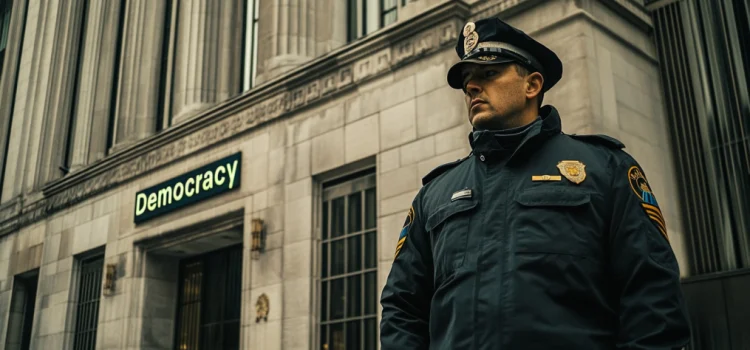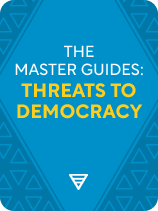

This article is an excerpt from the Shortform book guide to "The Master Guides: Threats to Democracy" by Shortform. Shortform has the world's best summaries and analyses of books you should be reading.
Like this article? Sign up for a free trial here.
Are you concerned about the state of democracy in your country? Do you wonder how to protect democracy in an increasingly polarized world?
Shortform’s Master Guide to Threats to Democracy explores practical solutions to safeguard democratic institutions. We’ll examine several approaches that aim to strengthen democracy and foster a more inclusive political landscape.
Read on to discover how you can play a role in protecting and revitalizing democracy in your community and beyond.
How to Protect Democracy
With apparent threats to democracy increasingly on the radar, experts have advice on how to protect democracy, contending that there are potential solutions and responses that can mitigate the threats. We’ll explore three of those strategies, looking specifically at:
- Institutional reforms
- Measures to reduce inequality, such as a global wealth tax
- Forging political coalitions that cut across demographic lines
Strategy #1: Institutional Reforms
In Why We’re Polarized, Klein recommends a set of reforms to American political institutions that reduce politicians’ incentives to stoke division. Klein argues that these reforms will put democracy on a sounder footing. Klein proposes three reforms:
- Replacing the Electoral College with a direct popular vote for the presidency
- Creating multi-member districts
- Changing the rules of the US Senate to eliminate the filibuster
1) Direct Elections for the Presidency
The first institutional reform Klein proposes is to replace the Electoral College with a direct popular election for the presidency.
According to Klein, the mechanics of the Electoral College create a built-in advantage for low-population, rural, and predominantly white states over high-population, urban, and ethnically diverse states. This effectively boosts Republicans while disadvantaging Democrats. And, Klein writes, in two of the most recent presidential elections, the anti-democratic flaws of the Electoral College have resulted in the Republican loser of the popular vote winning the presidency—George W. Bush in 2000 and Donald Trump in 2016.
Klein argues that replacing this system with a direct popular election for the presidency would be more democratically legitimate and force Republicans to compete on a more level playing field. If the party was forced to appeal to a majority of all voters instead of just its partisan base, Republicans would have far less incentive to engage in a polarizing style of politics. Instead, they would be compelled to reach out to and win over more middle-of-the-road voters and voters who don’t already share their ideology.
2) Multi-Member Districts
The second institutional reform Klein proposes is creating multi-member districts, in which more than one candidate can win a seat. This would be a significant departure from the US’s current system of winner-take-all single-member districts.
Under the current system, each district only has one representative. And because there’s only one seat to be won, voters have a strong incentive to gravitate toward one of the two major parties—instead of voting for a third-party candidate, which would split the vote and allow the rival party to win.
To illustrate this, imagine an election where there’s a right-wing Party A, a center-left Party B, and a further left Party C. If Party A receives 10,000 votes, Party B receives 9,999 votes, and Party C receives 8,000 votes, Party A wins the seat—Party B and Party C get nothing for winning a combined majority of the votes (64% or 17,999 out of 27,999 votes cast). Because the two left-wing parties split their votes, the right-wing party wins with a minority of the total vote (36% or 10,000 out of 27,999 votes cast).
Klein writes that this dynamic effectively rewards and reinforces the major parties’ tactics of unending partisan rhetoric and polarization: They know that their voters won’t abandon them or vote third party for fear of throwing the election to the rival party.
Multi-member districts would reduce the incentive for partisanship and polarization, observes Klein. If, for example, each district had five members—that is, the top five vote-getters earn a seat—voters would have more freedom to vote for the candidate they liked the best, since they wouldn’t have to worry about splitting the vote and inadvertently electing their least-preferred candidate.
3) Simple Majority Votes in the Senate
The third institutional reform Klein proposes is abolishing the legislative filibuster in the Senate and replacing it with a simple majority vote. The filibuster is a rule in the Senate that requires a bill to get a 60-vote supermajority (a 60% threshold in the 100-member chamber) to end debate on it. It can then go to a final floor vote, where it will then receive a simple majority up-or-down vote. Unless the majority party wins 60% of the Senate seats, the filibuster gives the minority party the means, motive, and opportunity to veto the majority’s agenda.
Klein writes that the filibuster breeds cynicism among the voters because it makes it impossible for the majority party to govern and implement the agenda it was elected to implement. Voters then become convinced that the majority party is corrupt, dishonest, or incompetent. They typically respond by punishing that party at the polls and electing the minority party to replace them—effectively rewarding the minority party for its obstructionism.
Without a filibuster, argues Klein, legislative majorities would have a greater ability to pass legislation and enact their agenda. This would tamp down the voter cynicism and disillusionment that helps foster polarization. Instead, voters would see a greater connection between their votes and actual policies enacted. If voters are pleased with the policies passed by the majority party, they can reward that party at the next election; if they’re displeased, they can vote them out. Klein argues that this is precisely how politics is supposed to work in a healthy, functioning democracy.
Strategy #2: Economic Reforms to Reduce Wealth Inequality
Earlier, we explored how wealth inequality erodes faith in democratic institutions: It exacerbates social divisions and convinces people that political and economic systems have turned their backs on them. That’s why addressing the challenge of wealth inequality isn’t only important from an economic point of view—it’s vital to the preservation of a democratic society. Experts propose some concrete steps to take on this challenge:
- A global wealth tax
- Transparency in the international financial system
- Progressive taxation
1) A Global Wealth Tax
In Capital in the Twenty-First Century, Piketty argues that since the 1980s, wealth inequality has made a troubling comeback that demands a response. His proposed solution is a global wealth tax.
Such a tax would be progressive, with higher fortunes taxed at a higher marginal rate than smaller fortunes. The tax would be relatively low (perhaps 1-2% of net worth per year) and would be assessed annually on the combined net worth of market assets of all asset classes.
Piketty argues that the purpose of the tax would not be to raise revenue. Instead, its purpose would be to stop the unchecked accumulation of wealth by the global hyper-wealthy, end the financial opacity that allows so much of the world’s wealth to exist in the shadows, and bring some much-needed redistribution of economic resources.
2) Greater Financial Transparency for the Global Financial System
Piketty further argues that even the assessment of such a tax would bring great clarity to the global financial system, as it would show precisely who owns what assets, how unequally wealth is distributed, and what policies might be best suited to address it.
The assessment of the global wealth tax would require significant (and unprecedented) sharing of banking data between countries and cooperation between tax authorities. But this degree of transparency would enable countries to accurately calculate the net worth of each of their citizens—regardless of where those citizens choose to hold their assets—and significantly cut down on tax evasion.
3) Progressive Taxation
Piketty argues that progressivity—in which the tax burden falls most heavily on society’s wealthiest—is necessary for the tax system to function fairly. He writes that if the system instead taxed the wealthy at lower rates and the poor at higher rates, middle- and working-class people (who vastly outnumber the rich) would rightly begin to question why they should pay a higher share than the rich.
Piketty notes that progressivity encompasses more than just the taxation rates applied to income. Progressivity also comes from the kind of income being taxed. In particular, taxes on wealth and inherited wealth (both of which are forms of capital income) especially could be powerful tools for scaling back the wealth inequality that’s defined most developed countries for the past 40 years.
Strategy #3: Overcome Social Divisions
As we’ve seen, so much of what threatens democracy comes from deep social divisions: mutual hostilities between opposing political camps that increasingly see one another as alien and dangerous. Under such conditions, democracy becomes steadily unworkable. Therefore, to preserve democracy, pro-democratic forces must overcome deep social divisions. Experts note three strategies to begin this healing process:
- Forging diverse coalitions
- Engaging in local politics
- Finding empathy for your political opponents
1) Forge Diverse Coalitions
In How Democracies Die, Levitsky and Ziblatt address the first strategy to overcome social divisions: forging broad, pro-democratic coalitions that cut across racial, ethnic, religious, and socioeconomic lines. In their analysis, it isn’t enough to simply build interest groups of like-minded activists. A broad coalition would entail liberals reaching out to conservative businesspeople, evangelicals, gun owners, and other traditional opponents. These groups all have sharp disagreements with one another on a range of issues, but would all potentially stand to lose if authoritarianism gained a stranglehold.
Levitsky and Ziblatt contend that, by their very nature and composition, these coalitions can appeal to a broader slice of the country and transcend the partisan divide. This defuses some partisan tensions, they argue, which can lead to depolarization and a strengthened democracy.
2) Engage in Local Politics
Writing in Why We’re Polarized, Klein explores the second of our strategies for overcoming social divisions: engaging in politics at a more local level. The routine concerns of local politics can often transcend ideological and identity-based grievances and bring different people together, fostering healthier democratic cooperation. By attending meetings of your local school board or engaging with local civic and nonprofit organizations, he writes, you’ll likely find that your neighbors—regardless of their party affiliation—still share the same desires for good roads, quality schools, and clean and honest government.
In A Promised Land, Obama makes a similar observation to Klein. He notes that democracy at the local level is often far more functional and can highlight points of agreement rather than division. Based on conversations with more conservative voters, Obama notes that traditional dividing lines in political life—white and Black, native-born and immigrant, conservative and liberal—obscure how most voters generally share the same set of concerns.
Although there are political disagreements, writes Obama, people everywhere worry about bread-and-butter issues like the cost of health care, the quality of education, and making sure their kids can enjoy even greater opportunities than themselves. According to Obama, despite the divisions, what unites us is far stronger than what divides us.
3) Find Empathy for Those You Disagree With
Following on the same theme as Klein and Obama, Hochschild (Strangers in Their Own Land) examines the third of our strategies for bridging social divisions: bringing liberals and conservatives together to overcome the compassion barrier that separates them. Each side, she writes, is too busy demonizing the other and reacting to caricatures of its political opponents, rather than substantively engaging with what the other side really believes and why they believe it.
In the US, for example, conservatives must recognize that liberals do not wish to impose their values on them or judge them for how they live their lives. And liberals must recognize that conservatives are not motivated solely by bigotry and hatred, nor are they uneducated or unsophisticated. Rather, their political beliefs and resentments stem from a long history of feeling marginalized and discarded by mainstream American culture.
By speaking more honestly with one another on an individual level and breaking out of their respective bubbles, liberals and conservatives would find that there is much that they actually have in common. On some level, she notes, both groups believe that the American economy has become unfair and rigged, with liberals believing that wealthy and powerful corporations are taking up too large a share of national income, and conservatives believing that the government is unfairly rewarding the indolent and lazy over the thrifty and industrious.
Hochschild writes that, however we do it, breaking down such barriers to compassion is the only way we can bring civility back to our politics and restore public faith in democratic institutions.
Exercise: Consider Your Role In Strengthening Democratic Institutions
Consider the steps you can take to support democratic institutions.
- Reflect on the current state of political polarization in your community or country.
- What mindsets do you have that might be incompatible with participating in a healthy democracy? For example, you may fear and distrust people from the other party or only consume partisan media.
- Can you identify ways that democracy is being threatened on a wider level? For example, you might observe a broadening wealth gap or declining participation and interest in democratic elections.
- What initiatives can you support in your community to better educate people about the democratic process and boost participation and confidence in it? For example, you might host workshops in local schools and community centers to teach civics education, register voters, and empower citizens with the knowledge and skills to actively participate in the democratic process.

———End of Preview———
Like what you just read? Read the rest of the world's best book summary and analysis of Shortform's "The Master Guides: Threats to Democracy" at Shortform.
Here's what you'll find in our full The Master Guides: Threats to Democracy summary:
- What the survival of democracy depends on
- The threats to democracy we should look out for
- How to fight back against democratic decline






